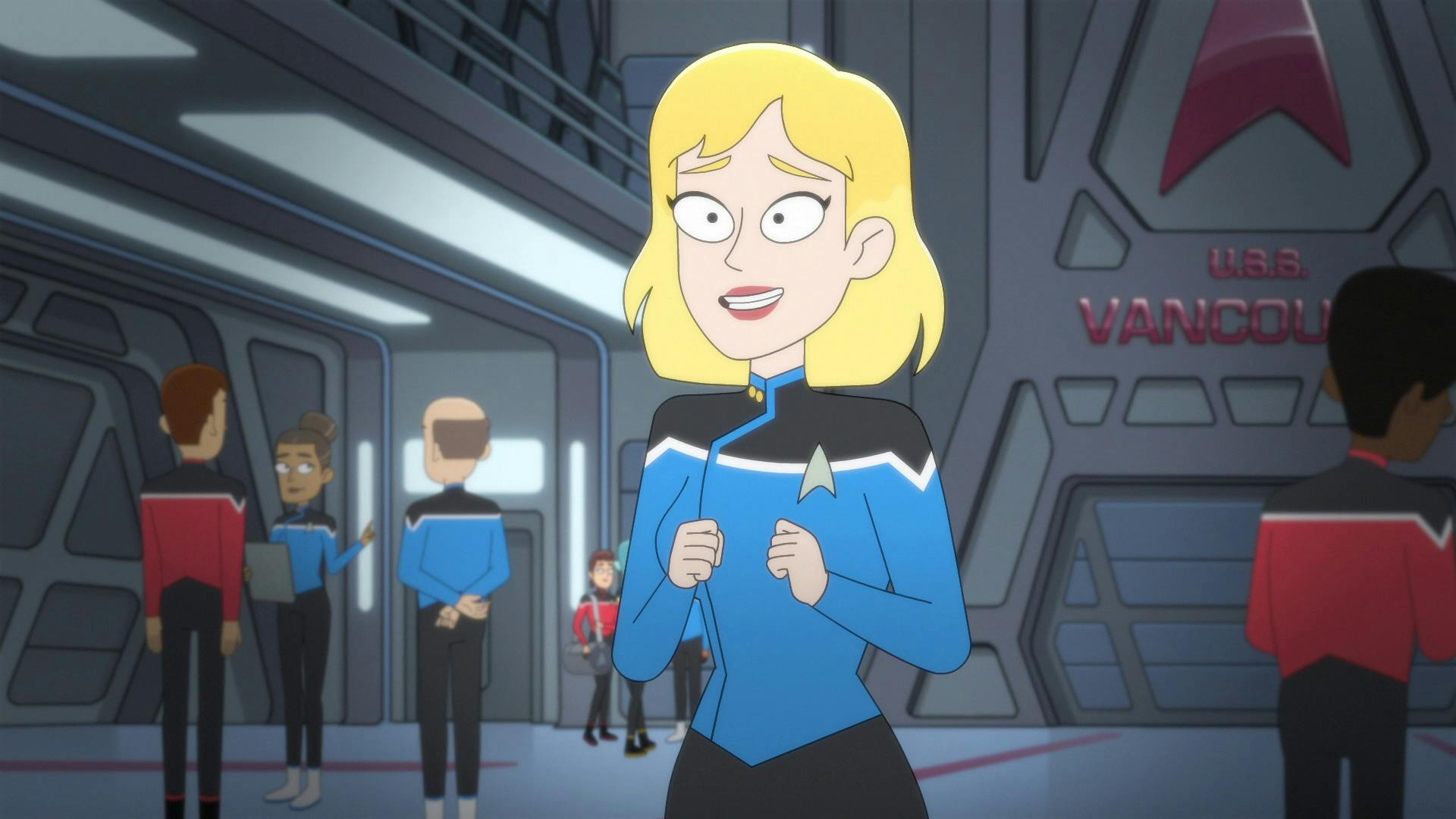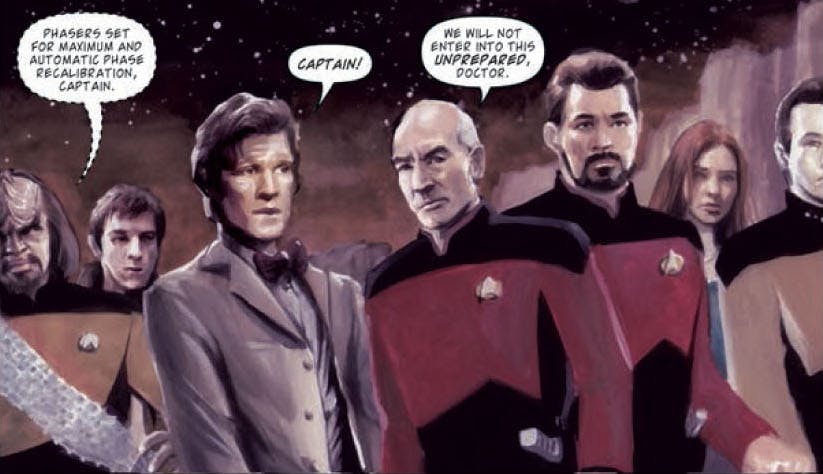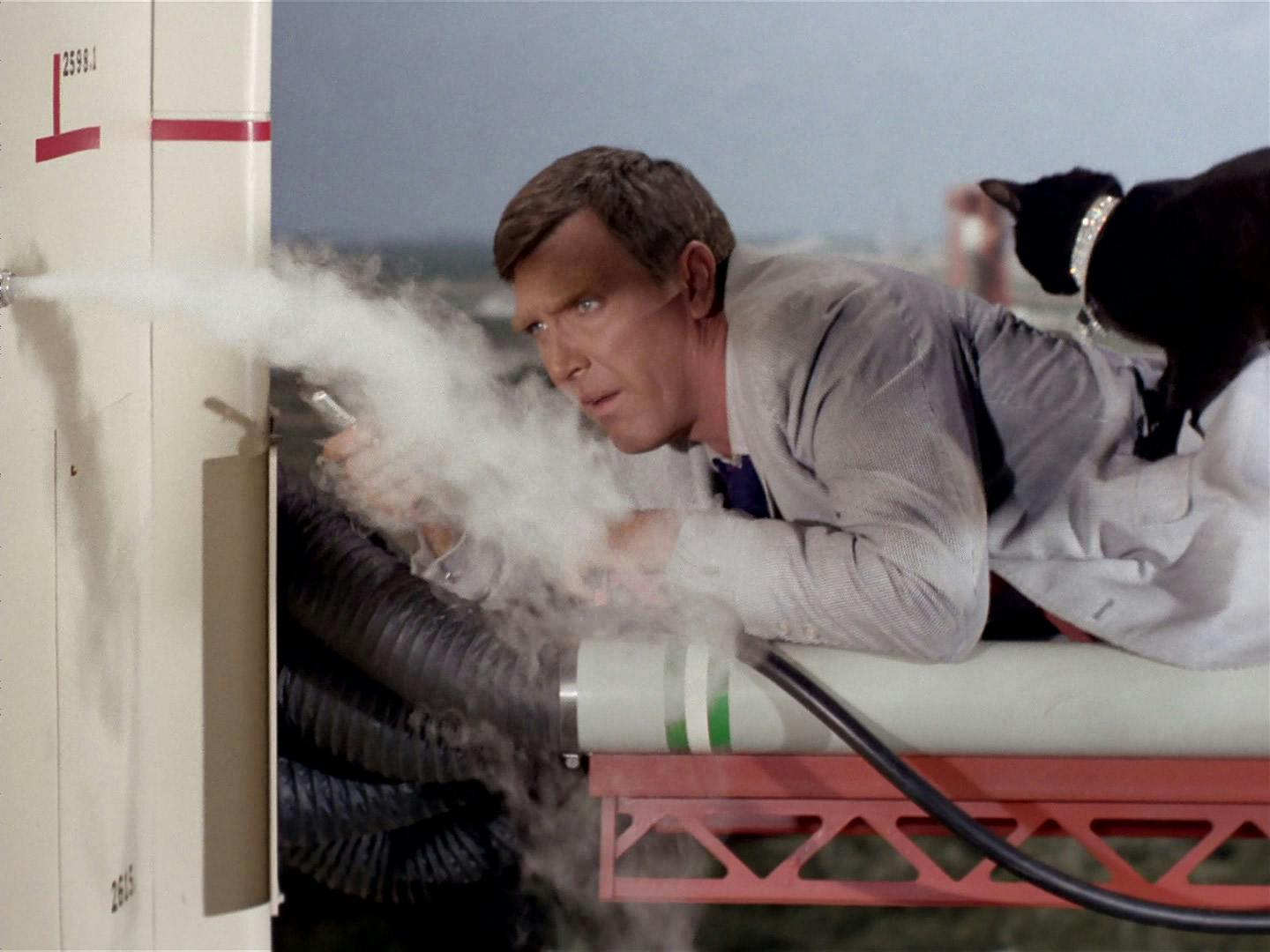Published Jul 30, 2024
Star Trek Has Always Loved Doctor Who — Here's the Proof
Starfleet and the Time Lords exist in different universes. But in our universe, Star Trek's nods to Doctor Who are very real.

StarTrek.com
During San Diego Comic-Con 2024, the showrunner of Doctor Who, Russell T Davies sat down with Star Trek's overall executive producer Alex Kurtzman .
It was an unprecedented moment, in which the Trek and Who franchises publicly acknowledged that their two fandoms crossover, and that in some ways, at least philosophically, these two worlds crossover.
But what if we told you this wasn't the first time Star Trek had given Doctor Who a public high-five?
The truth is, while Doctor Who has been dropping several Trek references since its revival in 2005, there are several examples of the Star Trek franchise overtly — or covertly — referencing the timey-wimey adventures of the TARDIS. Here's a brief guide to Star Trek's references to Doctor Who, throughout all time and space.
Sonic Drivers and Reversing the Polarity

"Cupid's Errant Arrow"
StarTrek.com
Fans of Doctor Who know that the titular Time Lord uses a multitool called a "sonic screwdriver." More than just a repair tool, the sonic acts as a kind of scanner, a transmitter, and sometimes as a defensive weapon. But this spacey tool seemingly exists in various forms in Star Trek, too. In 's "," frustrated with a locked door, Riker asks "Where's that sonic driver?"
In ' "," Lt. Barbara Brinson said “I managed to reverse the polarity and reboot the time stream.” Starting with the 1972 Doctor Who serial, the Third Doctor (Jon Pertwee) suggested "reversing the polarity of the neutron flow" to get out of a sci-fi pickle.
The idea of "reversing" a polarity didn't originate with Doctor Who per se, but it was certainly popularized by that series, a fact which various Star Trek incarnations have referenced many times. The Lower Decks shout-out is perhaps the most obvious because Barb also mentions rebooting the time stream, something that seems to happen often on Doctor Who. That said, Chief O'Brien, Geordi La Forge, and B'Elanna Torres had to reverse the polarity all the time.
The Other TARDIS?

"Future Tense"
StarTrek.com
In the episode "," the crew of the NX-01 encounters a small-ish pod that seems to be from the far future. While initially seeming very small, Reed, Archer, T'Pol and Trip soon learn this pod is much bigger on the inside than the outside. The crew discovers this ship operates using a "temporal displacement drive," which allows its dimensions to be much larger inside than out.
Enterprise writer and producer Mike Sussman has noted that the idea of this timeship was directly inspired by Doctor Who's TARDIS, and at one point, he'd even suggested that the ship could briefly be seen "morphing into a police call box," which was "nixed" by higher-ups at the time. That said, on some level, this idea still exists within the episode, which means we can't completely rule out that in some way, shape, or form, the timeship from Enterprise wasn't a TARDIS. Nobody is saying it is a TARDIS. But nobody's saying it isn't.
Just…The Doctor

"Message in a Bottle"
StarTrek.com
In the reality of Doctor Who, the Time Lord who stars in all the adventures, isn't actually named "Doctor Who," at least, we don't think so. Instead, they are called "The Doctor," a kind of fancy honorific that is also a proper name.
While this would be somewhat silly in real life, Star Trek fans are accustomed to this sort of thing. The omnipotent space deities all refer to themselves as "Q," despite all being different beings. The holographic Emergency Medical Hologram on decided to refer to himself as just "The Doctor," which makes him very much like The Doctor of Doctor Who.
Versions of the Doctor also crop up, in the 1985 Star Trek novel Ishmael, by Barbara Hambly, in which Kirk even seems to have knowledge of time travelers from the "Kasterborous galaxy," a clear reference to the home of the Time Lords, and the Doctor in Doctor Who.

STAR TREK: THE NEXT GENERATION / DOCTOR WHO - ASSIMILATION² #6
IDW Publishing
So, did Kirk and Spock ever meet a Time Lord? Well, in the 2012-2013 comic book crossover Assimilation², Kirk and Spock did meet the Fourth Doctor in a flashback, while the rest of the crossover concerned a team-up between the Eleventh Doctor, Amy Pond, Rory Williams, and the entire crew of the Enterprise-D.
Written by Scott Tipton, David Tipton, and Tony Lee, this crossover also made it clear that Guinan was aware of The Doctor, and that through her unique perception of time and space, was also aware when the timeline had been altered. This suggests that the Doctor's ability to perceive time and space is very similar to Guinan's, which could make the long-lived El-Aurians a kind of version of the Time Lords for the Final Frontier.
Then again, there's also another group of time travelers in Star Trek that might want to steal that crown.
Timey-Wimey Traveler

"Assignment: Earth"
StarTrek.com
Starting with The Next Generation's "," the Enterprise-D crew met "The Traveler," a character who could influence time and space through the power of thought.
Much later, we learned, in Season 2, that the Travelers were a group of beings who exist outside of spacetime and try to oversee the proper flow of time, among other multiverse-maintenance tasks. Retroactively, this has meant that the very Doctor-ish Gary Seven — from ' "Assignment: Earth" — has now been established as someone who worked as a "Supervisor" for the Travelers.
In the recently-aired Season 2, Wesley Crusher emerges as a kind of rogue Traveler, defying his instructions from the other Travelers to not interfere with the collapsing timeline of the Prime Universe. Throughout its second season, Wesley behaves very much like various versions of The Doctor from Doctor Who, starting with the fact that just like the Doctor defied the Time Lords in order to help people, Wesley ignores the instructions from the Travelers to leave well enough alone.

"The Devourer of All Things, Part I"
StarTrek.com
With and a mind that is way ahead of his rapid-fire speech, Wesley’s latest incarnation is a clear homage to various Doctors, from Tom Baker to David Tennant to Matt Smith, to Peter Capaldi and Jodie Whittaker. In our timeline, , making this crossover somewhat perfect for him in particular.
But beyond that, the writing team of Prodigy very obviously wanted Who fans to be seen. Not only does Wesley act like a Star Trek version of The Doctor, Dal mentions that the paradoxes of the Protostar's journey is a "timey-wimey," a phrase coined by the Tenth Doctor from the 2007 Doctor Who episode "Blink."
So, what was once somewhat sly, is now clear. Star Trek has its own almost Time Lord in the form of Wesley Crusher, Starfleet heroes like Dal R'El know about timey-wimey problems, and in both universes, most outer space problems that can't be solved by reversing the polarity are probably way too big for one episode.





